来自下更新世Karnezeika(希腊南部)地区的大型尾猿遗骸
IF 1.2
4区 地球科学
Q4 GEOSCIENCES, MULTIDISCIPLINARY
Earth and Environmental Science Transactions of the Royal Society of Edinburgh
Pub Date : 2022-11-07
DOI:10.1017/s1755691022000226
引用次数: 1
摘要
下更新世Karnezeika地区位于希腊南部伯罗奔尼撒半岛,其动物群对应于中维拉弗兰奇生物地貌单元(MN17)。被发现的哺乳动物群落包括一些大型颈猿的遗骸。在此,我们描述了这种材料,包括上第二磨牙、部分保留的近端桡骨,以及可能的上第一切牙。牙齿表现出晚期磨损,但仍保持其典型的丘疹特征,如强烈的舌裂和臼齿中的四个双齿尖。牙齿的一般形态和磨损模式排除了遗骸属于Theropithecus属的可能性,而相应材料的一般大小也排除了Macaca代表的可能性。相反,所研究的材料更适合Paradolichopithecus的大小范围。尽管该属在欧洲的维拉弗兰奇亚可能由一个物种Par.avernensis代表,但所研究材料的稀缺性提出了保留意见,因此Karnezeika papionin目前被称为Paradolichopithecus sp.。与欧洲其他地区一样,Paradolichupithecus记录在希腊很罕见,只在两个地方发现,Vatera和Dafnero。尽管数量稀少,但来自Karnezeika的新材料表明,这一重要分类单元在希腊半岛分布广泛。本文章由计算机程序翻译,如有差异,请以英文原文为准。
The remains of a large cercopithecid from the Lower Pleistocene locality of Karnezeika (southern Greece)
The Lower Pleistocene Karnezeika locality, lies in the Peloponnese, southern Greece, and its fauna corresponds to the Middle Villafranchian biochronological unit (MN17). The recovered mammal assemblage includes, among others, a few remains of a large Cercopithecid. Herein, we describe this material, including an upper second molar, a partially preserved proximal radius and, possibly, an upper first incisor. The teeth show advanced stages of wear but retain their typical papionin characters, such as a strong lingual cleft and four bilophodont cusps in the molar. The general morphology and wear pattern of the teeth rules out the possibility that the remains belong to the genus Theropithecus, while the general size of the corresponding material excludes the possibility of a Macaca representative as well. On the contrary, the studied material better fits the size range of Paradolichopithecus. Even though this genus is likely represented in the Villafranchian of Europe by a single species, Par. arvernensis, the scarcity of the studied material imposes reservations and thus the Karnezeika papionin is referred at the moment to cf. Paradolichopithecus sp. As in the rest of Europe, the Paradolichopithecus record is rare in Greece, having been found in only two localities, Vatera and Dafnero. Despite its scarcity, the new material from Karnezeika indicates a wide distribution of this important taxon in the Greek peninsula.
求助全文
通过发布文献求助,成功后即可免费获取论文全文。
去求助
来源期刊
CiteScore
2.00
自引率
0.00%
发文量
21
期刊介绍:
Earth and Environmental Science Transactions (formerly Transactions of the Royal Society of Edinburgh: Earth Sciences) is a general earth sciences journal publishing a comprehensive selection of substantial peer-reviewed research papers, reviews and short communications of international standard across the broad spectrum of the Earth and its surface environments. The journal prides itself on the quality of its graphics and photographic reproduction. The Editors are keen to encourage interdisciplinary papers and Transactions also publishes occasional special symposia and invited volumes of specific interest.
We are currently in the process of digitising the archive of RSE Publications, and the archive of the Transactions, dating back to 1788, will be available from the back issues link on this site.

 求助内容:
求助内容: 应助结果提醒方式:
应助结果提醒方式:


